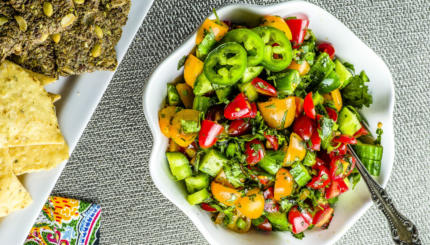Indian Carrot-Cardamom Halvah
Its origins are disputed, but there is no doubt halvah is one of the most common desserts in the world.
While it is disputed where it originated over 3,000 years ago–some say India, others Turkey, others say it was definitely Byzantine–there is no doubt that halvah is one of the most common desserts in the world. The flaky, dense, tahini-based candy known to American and Israeli Jews is only one of hundreds of different types of halvah eaten across the globe.Halvah (also known as halwa, halva, halava, helva, etc.) is a broad term used to describe desserts made with a base of flour or nut butter, such as sesame tahini, and sometimes including vegetables (such as carrots) or nuts. It is eaten in India, Central and West Asia, North Africa, the Balkans, and of course, in Israel and in Jewish delis throughout the United States. Each culture has its own halvah, united only by name–which derives from the Arabic word for “sweet”–and the fact that each is a sweetened candy or dessert, often an ancient and beloved recipe.
A trip to Israel is not complete without sampling the country’s halvah. Taking a stroll in Jerusalem’s Machane Yehuda market you can’t miss the halvah merchants, their tables piled high with huge slabs of the treat in a multitude of flavors, filled with different nuts and seeds, colored and flavored with various extracts. And because the dessert is pareve–neither meat nor dairy–it has always been the perfect kosher deli dessert. Many American Jews grew up on Joyva Halvah; Joyva brought the ancient treat to the United States in 1907, and more than a century later, production continues.
Below are three diverse halvah recipes: Israeli Tahini Halvah, Indian Carrot-Cardamom Halvah, and Greek Semolina Halvah. The only special tool needed is a candy or instant-read thermometer, for the Israeli halvah. Otherwise, these recipes are very simple to make–any recipe that has survived 3000 years should be! Each of these recipes can handle many variations. You can substitute different nuts or dried fruit, or add extracts, such as coffee, coconut, and vanilla. They will also keep very well, so they are great for making ahead and keeping on hand for last-minute guests.
This creamy, pudding-like halvah is incredibly easy to make, and is a great topping for ice cream or Greek yogurt, or an accompaniment to your favorite Baklava or crisp cookie.
Ingredients
pinch salt
1/2 cup golden raisins
1/3 cup sugar
1/2 teaspoon ground cardamom
1 lb carrots, peeled and grated
1 1/2 cups heavy cream
Directions
Combine carrots, cream, raisins, sugar, and cardamom in a heavy-bottomed saucepan. Bring to a boil; reduce heat to medium-low, and cover half-way with lid. Cook, stirring occasionally, until most of the liquid has evaporated, about 30 minutes.
Uncover completely and stir until all of the liquid has evaporated. The carrots will be completely soft and cooked through with cream and a shiny sheen coating each piece. It is better to have a bit of extra cream left in the pot than to risk scorching the bottom of the mixture.
Serve at room temperature or warm. When reheating, add a splash of cream if needed to reach the pudding consistency. Store for up to 10 days in the refrigerator in an airtight container.
kosher
Pronounced: KOH-sher, Origin: Hebrew, adhering to kashrut, the traditional Jewish dietary laws.
Yehuda
Pronounced: yuh-HOO-dah or yuh-hoo-DAH (oo as in boot), Origin: Hebrew, Judah, one of Joseph's brothers in the Torah.


